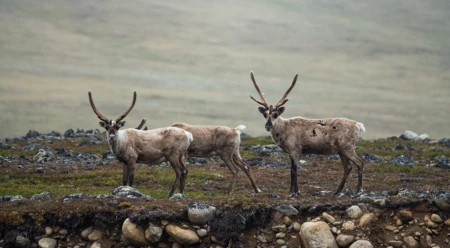Keepers of a Way of Life
In the Arctic, Gwich’in youth are learning that protecting land means preserving a way of life.
On Alaska’s North Slope, where polar bears den and gray wolves howl, protecting the land isn’t about supporting a cause or posting on social media from a protest at city hall. Here, it’s a matter of survival.
Jewels Gilbert never meant to become an environmentalist. Caring for the land was ingrained in her since childhood. She joined her dad for her first hunt at the tender age of 7. The now 20-year-old barely remembers it, but she knows that they’d start out from their home in Arctic Village, Alaska, some three hours up the clear blue Chandalar River, and rumble north by motorboat into the Arctic National Wildlife Refuge—19 million acres of wilderness—to seek sustenance.
Gilbert didn’t handle any weapons that first time; she watched and learned as her dad caught some brown-feathered ducks to bring home and roast.
Nowadays, Gilbert still rides up the same river to hunt in the bitter, nippy woods. The nostalgia always weighs heavy whenever she feels the wind’s frosty kiss on her skin or sees the river lapping toward the trees along the riverbank. Her 22-year-old boyfriend, Brennan Firth, joins her, and together they search for enough food to last them through the winter.
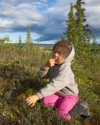
Arianna Gilbert takes a tasting break while learning how to forage for berries, a Gwich’in tradition. Photo: Keri Oberly
This tradition—stalking, shooting and skinning your meal—is a key way of life for the Gwich’in, the indigenous people who have roamed these lands for more than 20,000 years. Hunting isn’t optional; it’s necessary when a piece of steak costs as much as a box of ammunition. That’s why Gilbert is sure to say a little prayer in her native Gwich’in tongue after a successful catch. And all these skills—the language, the hunt and the craft of beading traditional clothing—she helps to pass along in her job teaching at the local elementary school.
“It’s pretty much who we are,” Gilbert says.
Gwich’in culture is now under threat. After decades of failed attempts, the Republican Party has finally opened up a portion of the Arctic National Wildlife Refuge to oil and gas interests. This industry could devastate the Refuge’s delicate ecosystem on which the Gwich’in depend. It’s not only home to polar bears and gray wolves, but also the revered Porcupine caribou calves along this 1.6 million-acre coastal plain—a site proposed for drilling that the Gwich’in consider sacred.
Not all young people are as excited about living the way Gilbert and Firth do, but community leaders—from elders to teachers—are playing an active role in showing the youth the way. For the Gwich’in, maintaining their culture may be their best chance to save the Refuge.
In the Arctic, the purpose isn’t advocacy or activism. The purpose is, well, life. As in the Lower 48, roughly 95 percent of food many Alaskans eat is imported, per a 2014 report commissioned by the state. But relying on grocery shelves is a luxury the Gwich’in don’t need. They’ve known this life—of hunting and gathering—as long as they’ve existed.
“[Protecting the Refuge] is a huge part of their way of life and their future,” says Bernadette Demientieff, the executive director of the Gwich’in Steering Committee, which has been protecting the Refuge from fossil fuel exploration since 1988. Demientieff has been actively involved in safeguarding the Refuge since 2005, and she’s learned to roar when she talks about it.
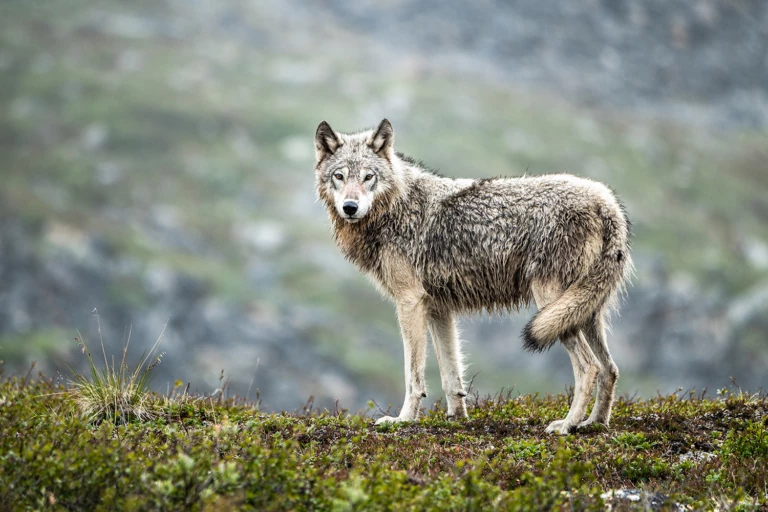
The Arctic Refuge is home to gray wolves, including this one seen in the Jago River valley, Alaska. Photo: Austin Siadak
This First Nation has been shouldering this responsibility for what feels like forever. Republicans have been trying to extract natural resources from the Refuge since 1980 when President Jimmy Carter signed the Alaska National Interest Lands Conservation Act, which made exploration possible. Under President Donald Trump, attempts to drill in the Refuge are accelerating.
Meanwhile, Gwich’in youth have been around amid all this.
Demientieff was about 12 years old when this all began. Even at that young age, she knew protecting the land was urgent. Now, that urgency is even more palpable. That’s why the Gwich’in Steering Committee is creating an official youth board, which will offer the youngsters a platform to help defend the Refuge. Some seven youth joined in June.
But it’s not always easy to introduce youth to their culture (while maintaining interest). Staying inside is much more appealing in the age of iPads, PlayStations and, well, the internet. Interacting with the land doesn’t sound as lit when the latest social media trend is taking over teenagers’ feeds.
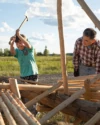
Getting an early education into traditional ways. Nine-year-old Cannon Cadzow helps his grandfather Earl build a fish wheel for salmon season. Photo: Keri Oberly
This wasn’t always the case. Wanda Pascal remembers; she’s always lived off the land. At 58, she still wanders the mountains in the fall to gather her winter supply of Labrador tea leaves, which her people have learned benefit their stomachs. The former chief of Fort McPherson in Canada still goes out to hunt. No one’s got their dog teams handy to pull them across the ice anymore, though. Things were easier then, she says. Dogs are pretty reliable. Pascal now depends on trucks and snowmobiles, or Ski-Doos as she calls them. Gas is expensive, and, ahem … vehicles can break down.
“If I go into the school and explain to the kids what I learned when I was small,” Pascal says, “some of them wouldn’t believe me.”
Change is always tough, but now Pascal has upgraded to being the teacher, not the student. Her grandfather taught her to hunt and work with caribou. Her grandmother taught her how to cut it. She’s now teaching those same skills to her grandkids. And no, she won’t let them bring their gadgets and gizmos outdoors—except for maybe their cellphones to snap some pics.
“If they want caribou or dry meat, they have to go out and help us hunt,” Pascal says. “They have to work hard to get what they want.”
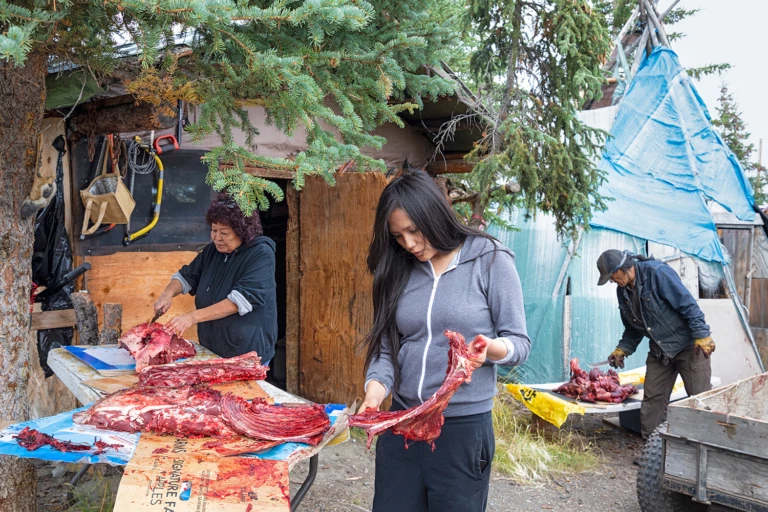
The Gilbert family and friends cut up caribou meat at their home in Vashrąįį K’ǫǫ, Alaska. Opening up the Refuge to extractive industries threatens this Gwich’in tradition. Photo: Keri Oberly
This past spring, the grandmother joined her 15-year-old granddaughter for a camping trip with some friends in the Richardson Mountains, whose snow-covered peaks glistened just beneath a setting sun. There, some 20 minutes west of their home, the girls tried to find caribou among the white mountains. They didn’t find any, but another hunter gladly gave them some.
Pascal is constantly teaching her family the basics: how to pick berries, find traditional medicine in the woods, fish and, of course, hunt caribou. She can cook it any which way you can think of—in a burger, fried, stewed, boiled or dipped in grease to be roasted by the fire. This, too, the next generation must learn.
And Pascal’s five grandkids are up to the task. Her 3-year-old grandson even joins them on their ventures through the snow. Her 11-year-old granddaughter, J’lyn Valentsi, is already winning awards for being her grade’s most traditional on the land. Some schools may celebrate perfect attendance, but for the Gwich’in, carrying on the culture is worth an accolade.
Valentsi is happy to receive that honor, she says, and “proud.” She’s only in fifth grade but already recognizes that these lessons will help keep her culture alive. She knows that it means keeping the Refuge safe.
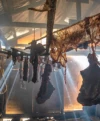
Caribou meat is hung in a smoke cache, then stored in freezers for the winter. Youth learn from the elders how to prepare and store food to last through the cold months. Photo: Keri Oberly
“We have to protect the caribou for the generations to come,” Valentsi mumbles as she takes a break from working on traditional mitt strings.
She’s still just a kid, after all.
Some experts, however, might deem kids like Valentsi particularly “successful.” Ronald Ferguson, an economist who teaches public policy at the Harvard Kennedy School, has written about raising successful children, and his equation is simple. He says they’ve got to be smart with a sense of purpose and agency—aka the ability to step up and follow through on achieving their purpose, a combo that equals full realization.
“Activism very clearly entails having purpose and then acting on that purpose,” Ferguson says. “If you’re an effective advocate, you probably did it in a way that was pretty intelligent.”
If they’ve got the skills, why stop?
Passing along survival skills in the land of months-long darkness will help keep the Refuge safe, argue tribal members. Ultimately, it’s what will keep their people safe. Members of the Gwich’in have been going around the US to tell representatives why the fossil fuel industry has no place in the Arctic National Wildlife Refuge. Gilbert, for instance, went to Washington, DC, to lobby on behalf of the Gwich’in Steering Committee back in 2016. Pascal was in New York City just this past April to meet with United Nations officials.
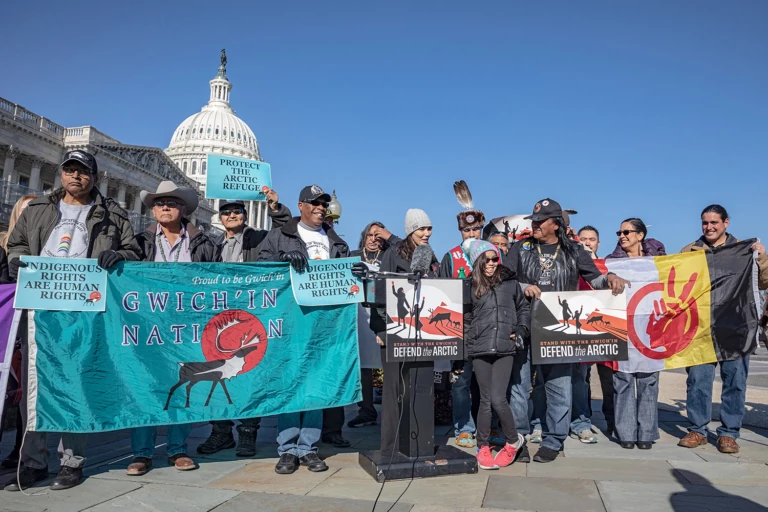
Members of the Gwich’in Steering Committee at a press conference in front of the United States Capitol in Washington, DC. The Gwich’in know the fight to protect the Refuge isn’t just about protecting their own backyard, but about protecting sacred spaces everywhere. Photo: Keri Oberly
They want Congress to understand that the Arctic National Wildlife Refuge isn’t just a piece of pristine nature. It’s The Sacred Place Where Life Begins, as the Gwich’in describe it. Before it was a national wildlife refuge, these were Gwich’in hunting grounds. Just as the Porcupine caribou migrate through the Refuge, so did the Gwich’in historically. In fact, their villages throughout Alaska and Canada exist today, in part, due to this migratory route. But they would never enter the Refuge coastal plain.
They know that Porcupine caribou migrate through these lands to eventually arrive at the Refuge coastal plain to give birth to their calves safely. In the coastal plain, caribou can avoid predators more common to the surrounding mountains and find refuge from insects, like mosquitoes on ice fields and gravel bars. It’s their haven.
“It is our belief that the future of the Gwich’in and the future of the caribou are the same,” said the late Gwich’in elder Jonathan Solomon. “Harm to the Porcupine caribou herd is harm to the Gwich’in culture and a millennia-old way of life.”
Bringing youth into this equation—and connecting them to the land—is key to maintaining this space for wildlife. They need to understand what’s at stake if it’s lost.
Really, though, youth reclaiming their culture isn’t happening only in the Arctic. It’s happening worldwide and all in the name of their lands, water and world. A lot of this newfound energy took hold in 2016 when Sioux youth decided to take a stance against the Dakota Access pipeline. They completed a 2,000-mile relay run from Standing Rock in North Dakota to Washington, DC, to deliver a petition opposing the oil project.
While that pipeline wound up happening, the energy to resist lives on today—in the Gwich’in, for instance.
Gilbert and Firth have been walking these frozen lands as long as they can remember. Their people have depended on the caribou since time immemorial. Whenever the young couple journeys the Refuge, they may see duck and geese fly over, or run into an elusive gray wolf while hunting caribou. But all that is at risk now.
“It’s just beautiful. Everything is quiet. You hear nothing but animals,” Gilbert says. “It’s home.”
Protect the Refuge
Send a message to your Senator today and urge them to cosponsor the Arctic Refuge Protection Act of 2019.
